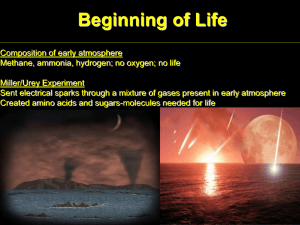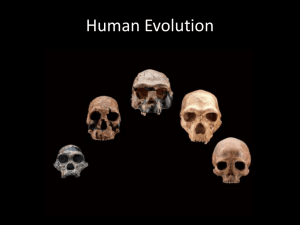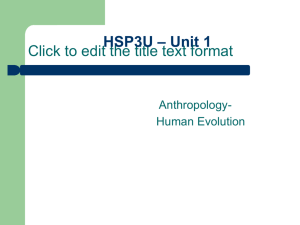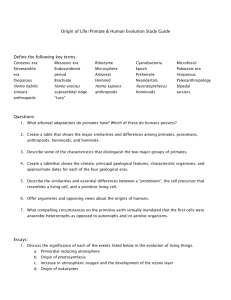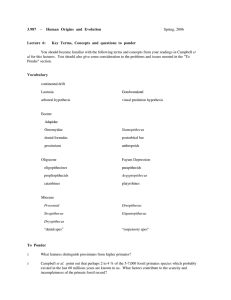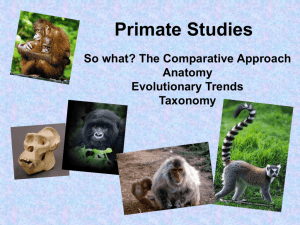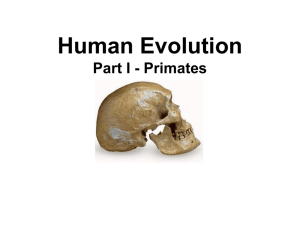HCCAnthPhysicalreview32010.doc
advertisement
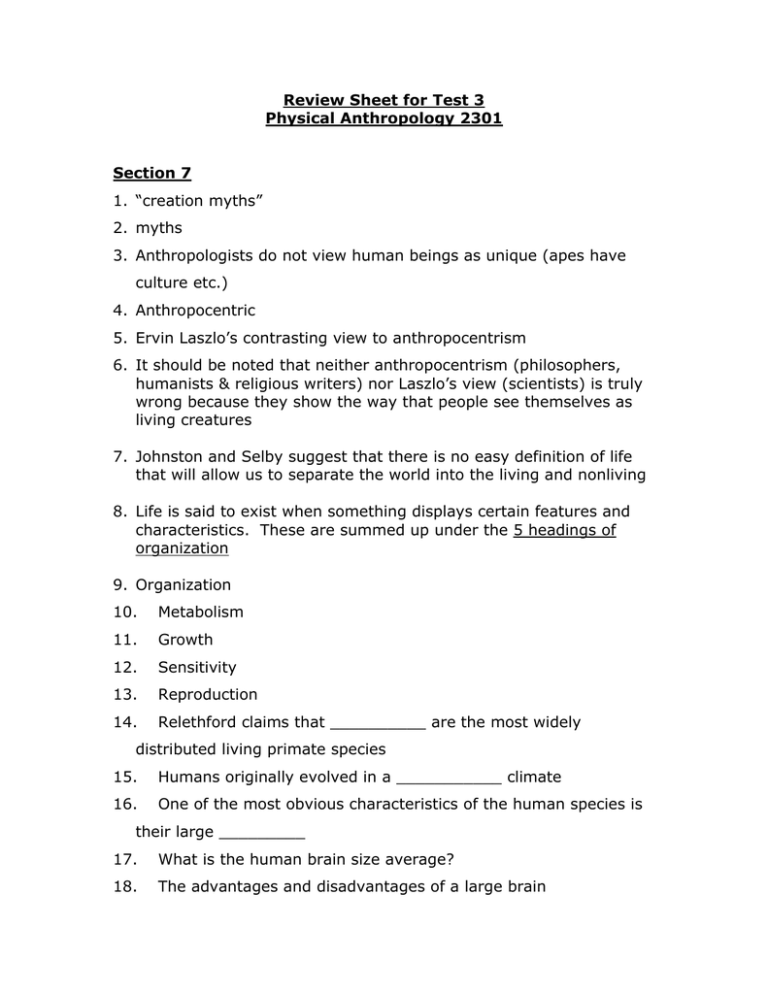
Review Sheet for Test 3 Physical Anthropology 2301 Section 7 1. “creation myths” 2. myths 3. Anthropologists do not view human beings as unique (apes have culture etc.) 4. Anthropocentric 5. Ervin Laszlo’s contrasting view to anthropocentrism 6. It should be noted that neither anthropocentrism (philosophers, humanists & religious writers) nor Laszlo’s view (scientists) is truly wrong because they show the way that people see themselves as living creatures 7. Johnston and Selby suggest that there is no easy definition of life that will allow us to separate the world into the living and nonliving 8. Life is said to exist when something displays certain features and characteristics. These are summed up under the 5 headings of organization 9. Organization 10. Metabolism 11. Growth 12. Sensitivity 13. Reproduction 14. Relethford claims that __________ are the most widely distributed living primate species 15. Humans originally evolved in a ___________ climate 16. One of the most obvious characteristics of the human species is their large _________ 17. What is the human brain size average? 18. The advantages and disadvantages of a large brain 19. Poirer sees increased size and complexity in the brain as being related to tool use and manufacture, increasing environmental challenges and more complex social groups 20. Increased brain size and complexity may be related to an infants slower maturation rate which requires extended parenting (this higher level of infant care allows for more infant socialization placing a premium on learning abilities) 21. The function of the brain for storing and processing information is largely independent of shape so there are no selective demands to alter shape (new demands are met by changes in the neural networks) 22. Larger mammalian brains are produced by ________________________ and humans also slow down the rate of body growth to produce a high brain/body ratio 23. Allometry 24. Bipedalism 25. Stanford states that we have absolutely no reason to think that bipedalism arose for one reason only 26. One of the earliest theories was the idea that tool use was fundamental to making us human. Evidence against this theory is that tools appeared _______ m.y.a. and bipedalism began about _______ earlier. 27. Lovejoy claims that food carrying (walking across a savannah), monogamy (male needs to carry food to the female) and the female reproductive system (female protohominids did not advertise their ovulation—sexual swellings such as the pink balloons on the backs of female chimpanzees) led to bipedalism 28. 3 arguments against Lovejoy 29. Stanford believes that the development of bipedalism did not happen for one reason or in one step 30. 3 benefits of bipedalism Section 8 1. Primates (def.) 2. The order of primates includes? 3. Have all the major primate groupings been discovered? 4. Primates are the most familiar placental mammals. 5. Placental mammals 6. Pentadactyl 7. Nails 8. Prehensile feet 9. Use of fingers 10. Power grip 11. Precision grip 12. Binocular vision 13. Their olfactory sense is ___________ and their postnatal life period is _________. 14. Movement style and anatomy 15. Most primates are__________, but some are _________ and most except gorillas and humans sleep in _________. 16. Most primates are diurnal. 17. Primates are intelligent and adaptive and many are omnivorous. 18. Sellers’ two problems with defining primates 19. The two traditional suborders of primates 20. The two new suborders 21. The placement of the tarsiers is still a major issue in primatology 22. The subdivisions of anthropoids 23. Prosimians (def.) 24. The first primate like animals (prosimians) appeared during the __________. 25. The prosimians contain _______, _________ and tentatively ____________. 26. Prosimian characteristics 27. Lemurs 28. Lorises 29. Tarsiers 30. General features where anthropoids differ from prosimians 31. New world monkeys and platyrrhini 32. New World Monkey characteristics 33. Their two families 34. Callithricidae 35. Cebidae 36. Old World monkeys or Catarrhini 37. Cercopithecoidea 38. Old World Monkey characteristics 39. Cercopithecinae 40. Colobinae 41. Catarrhini characteristics 42. Hyblobatidae family 43. Pongidae family 44. Gibbons 45. Orangutans 46. Gorillas 47. Chimpanzees 48. Bonobos Section 9 1. Turnbaugh etc. see the original roots of the primate order as going back to the beginnings of placental mammal radiation __________ years ago 2. Plesiadaptiforms 3. The earliest identifiable primates are from the _________ Epoch 4. 3 theories on the development of the first true primates 5. During the _______ or the late _________ the first anthropoids arose in Africa and some “rafted” to South America 6. Anthropoids 7. During the Oligocene epoch anthropoids began to switch from __________ (active at night) activities to ________ (daytime) 8. During the Miocene there were many more forms of hominoids than there are today and it was known as ________________________ 9. hominoids 10. 4 issues that arise concerning simplification of the evolutionary situation 11. mosaic evolution 12. The earliest members of the hominid lineage date to ______ to _______ million years ago 13. Relethford claims that the first hominids have been found only in ______ 14. Ardipithicus Ramidus—Pliocene epoch--many scientists (until recently) believed that “Ramidus” was close to the point of divergence of apes and protohumans (evidence of bipedalism) and lived in an arboreal environment 15. Australopithecus Anamensis---Relethford sees this as the first hominid 16. Australopithecus 17. As late as 2000 there were only 2 genera in use for hominids, specifically, Australopithecus and Homo 18. Australopithecus Afarensis—was until recently the earliest hominid for which sufficient diagnostic anatomical evidence was available 19. Lucy 20. 3 species of robust Australopithecines 21. homoplasy 22. Is the robust group monophylectic? 23. Sagittal crest 24. Although robustus implies a large powerfully built body newly discovered skeleton parts show that this hominid ranged in size from ______________ pounds 25. Australopithecus Boisei—there is some evidence of tool use by this group, but it is generally assumed that the tools were associated with homo 26. Australopithecus Africanus and Australopithecus Garhi are the leading choices for our ancestors during the ______ m.y.a. time period. 27. A. Garhi was a maker of stone tools to break open bones for their marrow
